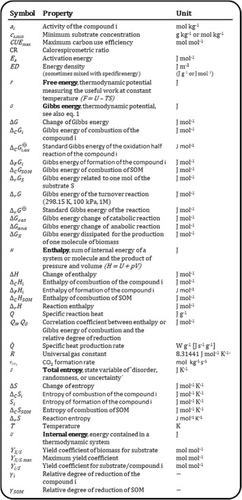当前位置:
X-MOL 学术
›
Soil Biol. Biochem.
›
论文详情
Our official English website, www.x-mol.net, welcomes your feedback! (Note: you will need to create a separate account there.)
Assessing energy fluxes and carbon use in soil as controlled by microbial activity - A thermodynamic perspective A perspective paper
Soil Biology and Biochemistry ( IF 9.7 ) Pub Date : 2024-03-21 , DOI: 10.1016/j.soilbio.2024.109403 Matthias Kästner , Thomas Maskow , Anja Miltner , Marcel Lorenz , Sören Thiele-Bruhn
Soil Biology and Biochemistry ( IF 9.7 ) Pub Date : 2024-03-21 , DOI: 10.1016/j.soilbio.2024.109403 Matthias Kästner , Thomas Maskow , Anja Miltner , Marcel Lorenz , Sören Thiele-Bruhn

|
Soil organic matter (SOM) plays a central role for both the C cycle and soil functions. Plants provide the input and heterotrophic (micro)organisms are essential for the turnover. Microbial metabolism links matter and energy fluxes and generates the highest energy turnover dynamics in SOM because the organisms need both energy and matter for maintenance and growth. In this perspectives paper, we evaluate the knowledge on thermodynamic approaches potentially applicable to study the turnover of organic matter in the soil system. Thermodynamics is essential for understanding organic matter turnover in soil as turnover and storage are controlled by the energy supply to, and consumption by, microbes. Instead of just comparing the heat of combustion of compounds without considering microbial anabolism, we need to apply conventional thermodynamic state variables that can be either estimated using established thermodynamic equations, or measured empirically in soil. In particular, we can follow and quantify overall changes of enthalpies by calorimetry. Here, we suggest to apply a thermodynamic concept with the related experimental approaches of calo(respiro)metry and turnover mass balances including biomass formation. This enables us to better interpret and understand the highly variable carbon use efficiency (CUE) in a multi-substrate system such as soil and to relate this to energy use efficiency (EUE). Combining the experimental measurements of the thermodynamic state variables with mass turnover data allow prediction of whether compounds can be metabolized with energy delivery to microorganisms, or be thermodynamically stabilized under the respective redox and electron acceptor conditions. Energy balancing shows how much energy is actually used and retained in the soil, how much is emitted as heat, and how much may be stabilized due to endergonic turnover reactions. Thermodynamic stabilization should therefore be considered as basic stabilization process for organic compounds in soil.
中文翻译:

评估微生物活动控制下的土壤能量通量和碳利用 - 热力学视角 透视论文
土壤有机质 (SOM) 在碳循环和土壤功能中发挥着核心作用。植物提供输入,异养(微生物)生物对于周转至关重要。微生物代谢将物质和能量通量联系起来,并在 SOM 中产生最高的能量周转动态,因为生物体需要能量和物质来维持和生长。在这篇展望论文中,我们评估了可能适用于研究土壤系统中有机质周转的热力学方法知识。热力学对于理解土壤中有机物的周转至关重要,因为周转和储存是由微生物的能量供应和消耗控制的。我们需要应用传统的热力学状态变量,而不是仅仅比较化合物的燃烧热而不考虑微生物的合成代谢,这些变量可以使用已建立的热力学方程进行估计,也可以在土壤中根据经验进行测量。特别是,我们可以通过量热法跟踪和量化焓的总体变化。在这里,我们建议应用热力学概念与热量(呼吸)测量和周转质量平衡(包括生物量形成)的相关实验方法。这使我们能够更好地解释和理解土壤等多基质系统中高度可变的碳利用效率(CUE),并将其与能源利用效率(EUE)联系起来。将热力学状态变量的实验测量与质量周转数据相结合,可以预测化合物是否可以通过向微生物传递能量而代谢,或者在各自的氧化还原和电子受体条件下热力学稳定。能量平衡显示了土壤中实际使用和保留了多少能量,有多少能量以热量的形式散发,以及有多少能量可以由于吸能周转反应而稳定。因此,热力学稳定应被视为土壤中有机化合物的基本稳定过程。
更新日期:2024-03-21
中文翻译:

评估微生物活动控制下的土壤能量通量和碳利用 - 热力学视角 透视论文
土壤有机质 (SOM) 在碳循环和土壤功能中发挥着核心作用。植物提供输入,异养(微生物)生物对于周转至关重要。微生物代谢将物质和能量通量联系起来,并在 SOM 中产生最高的能量周转动态,因为生物体需要能量和物质来维持和生长。在这篇展望论文中,我们评估了可能适用于研究土壤系统中有机质周转的热力学方法知识。热力学对于理解土壤中有机物的周转至关重要,因为周转和储存是由微生物的能量供应和消耗控制的。我们需要应用传统的热力学状态变量,而不是仅仅比较化合物的燃烧热而不考虑微生物的合成代谢,这些变量可以使用已建立的热力学方程进行估计,也可以在土壤中根据经验进行测量。特别是,我们可以通过量热法跟踪和量化焓的总体变化。在这里,我们建议应用热力学概念与热量(呼吸)测量和周转质量平衡(包括生物量形成)的相关实验方法。这使我们能够更好地解释和理解土壤等多基质系统中高度可变的碳利用效率(CUE),并将其与能源利用效率(EUE)联系起来。将热力学状态变量的实验测量与质量周转数据相结合,可以预测化合物是否可以通过向微生物传递能量而代谢,或者在各自的氧化还原和电子受体条件下热力学稳定。能量平衡显示了土壤中实际使用和保留了多少能量,有多少能量以热量的形式散发,以及有多少能量可以由于吸能周转反应而稳定。因此,热力学稳定应被视为土壤中有机化合物的基本稳定过程。



























 京公网安备 11010802027423号
京公网安备 11010802027423号